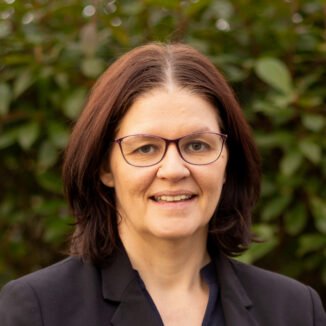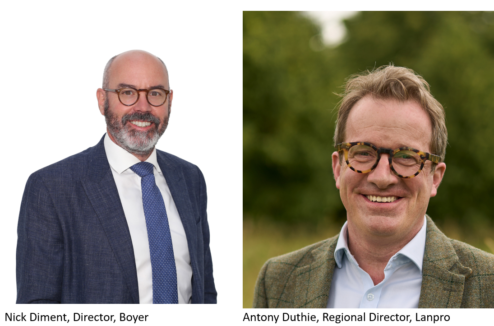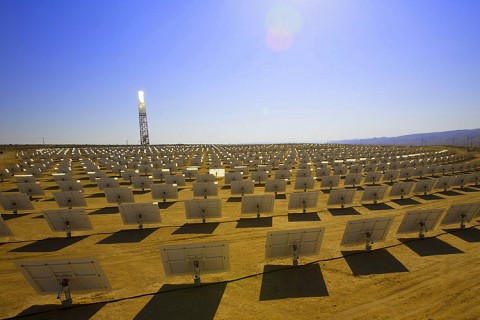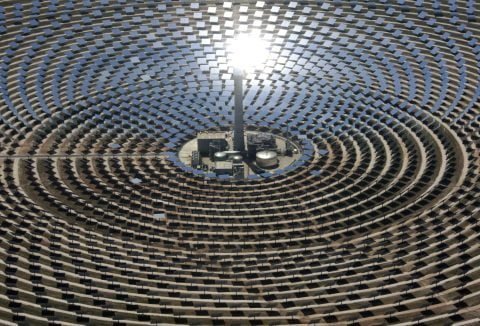Can the Sahara Desert really meet Europe's voracious appetite for energy? The Desertec solar power project aims to do just that, but a host of obstacles remain. Overly optimistic expectations are now being scaled down as the project starts to take shape.
When the sun rises and it’s still hazy over Andalusia, the future is particularly visible. That’s when beams of light as thick as tree trunks and as sharp as lasers slice through the haze. They come together just below the tops of two towers, the taller of which rises 162 meters (531 feet) into the sky, taller than Cologne Cathedral. These light beams are not being emitted by some UFO, but are in fact the core of the most advanced solar power plant in the world.
The towers are surrounded by close to 2,000 mirrors that face the sun. Each mirror has a surface area of about 120 square meters (1,290 square feet) and, like flowers, they follow the light, to the sound of a rattling motor that orients them toward receivers up in the towers. The bundled solar energy, which reaches a temperature of 250 degrees Celsius (482 degrees Fahrenheit), strikes steel pipes through which water is conducted. The water vaporizes and drives a turbine. The facility, known as PS20, is the world’s largest solar power tower and generates enough electricity for 10,000 households.
There is not a cloud in the sky on this spring morning, 20 kilometers (12.5 miles) west of Seville. “It’s easy today,” Enrique Sales Rodriguez says with satisfaction, as the turbine roars and the tower runs at full capacity. Rodriguez, an engineer, monitors the technology from a control room at the base of the tower. He reacts quickly whenever large clouds appear in the sky, making adjustments to the system to extract as much energy as possible from the rays of the sun. Everything is designed to increase the harvest of light. Trucks equipped with large blue cleaning brushes are constantly roaming through the rows of mirrors. “We clean 24 hours a day,” says Rodriguez.
Rapt Reception
The solar towers at the Solucar plant, which is owned by the Spanish Abengoa group, are the most futuristic system the solar industry can offer today. Scientists love this technology, because it is capable of converting so much solar heat into electricity.
Solucar is a prototype of sorts for Desertec, the 21st century’s energy production mega-project. The bold concept is designed to provide Europe with clean, renewable energy in the form of solar power from the Sahara. It has the capacity to avert the energy crisis and stop climate change, while simultaneously combating poverty in Africa. Not surprisingly, experts and politicians alike applauded when 12 companies initiated the Desertec Industrial Initiative last summer. The consortium includes multinational corporations like Siemens, major banks like Deutsche Bank and energy giants like E.on and RWE. They are all eager to be involved, if and when the dream becomes reality.
German Chancellor Angela Merkel was enthusiastic, the president of the European Commission was rapt and ordinary people were fascinated. The plan foresees Europe deriving almost all of its electricity from renewable sources within 40 years from now, with a sizable portion of it coming from the Sahara. For many people, the dream is even more momentous than the Moon landing. But, at an almost inconceivable estimated cost of €400 billion ($492 billion), it would also be more expensive.
One day, the plants in the Sahara could provide Europe with 700 terawatt hours of energy a year, more than the combined energy generated by 100 nuclear power plants. At first, it seemed as if the project could get off the ground in no time, with German reinsurance giant Munich Re providing the funding, Deutsche Bank providing loans and Siemens building one mammoth solar power plant after another in the sands of the Sahara.
Huge Expectations
That, at least, was what the governments of North Africa had been led to believe. “Desertec faces a problem, because public expectations have become too big,” says Mike Enskat, who coordinates energy issues in North Africa for the German Agency for Technical Cooperation (GTZ). The people there, says Enskat, “thought to themselves: Here comes Desertec, and they’ll be throwing billions around.”
But it isn’t quite that easy. All it takes is a visit to the Munich office of the Desertec Industrial Initiative to quickly realize that the future is still a long way off. “It’s a small startup, a room with eight people in it,” says Desertec spokesman Alexander Mohanty. The office is so crowded that he has to walk out into the hallway if he wants to make a phone call in peace. Each of the participating companies pays €150,000 a year into the group fund, the sort of money companies like Siemens or RWE could pay out of their petty cash. Desertec CEO Paul van Son, an affable Dutchman, is the first to dampen expectations. “We’re not investors,” he says, “and we’re not project developers.”
What are they then?
“We are an idea,” says van Son, “a movement”. For the time being, the disciples of light keep themselves busy lobbying the German government, the European Union and other governments in Europe and North Africa, hoping to find out what exactly Desertec should be asking for, and what underlying conditions must first be fulfilled to turn the idea into reality. Initial construction plans have also been produced.
Dependent on Taxpayers and Consumers
The Desertec companies want to invest, but only if there are purchase and price commitments, and there are guarantees and support from organizations such as the World Bank and climate funds. Desertec will not materialize without money from taxpayers and power consumers. And Desertec is also dependent on the E.U. countries replacing their national energy policies with a European energy policy. The project will also require finding a way to deal with North African governments such as Libya’s, which aren’t exactly known as model democracies.
Morocco, in particular, is being targeted for test projects in the next few years. Anyone can participate in the bidding process for these projects, not just the Desertec companies. Once the experience gleaned from the pilot projects have improved the technology and reduced costs, the next bidding rounds can begin.
Even then, Desertec’s mammoth power plants, images of which have been circulating in the media in recent months, will still not materialize yet. If the approach proves to be successful and larger-scale construction begins, it will probably not be in the form of a few gigawatt plants. Instead, it is more likely that thousands of medium-sized power plants, financed by large numbers of investors, will sprout up in many locations in the desert. At best, the Desertec logo will be affixed to the plants as a sort of environmental seal of approval. The power plants themselves will be built and paid for by others. “We are trailblazers,” says van Son. “Then we’ll turn everything over to the market.”
‘More Realistic’
This is not as extensive a development as many have believed until now, but it is far more realistic, says Fritz Vahrenholt, who heads RWE’s renewable energy division. He says that he was troubled by the “exaggerated optimism” associated with the Desertec project, and he is not convinced that Europe will meet a significant portion of its energy needs with electricity from the Sahara in 15 years’ time. Nevertheless, says Vahrenholt, RWE now views the project “with significantly more confidence than in the past.”
This optimism is fueled by expectations that solar thermal technology could soon be competitive. Experts reckon that costs, currently at about 20 euro cents per kilowatt hour, will be cut in half within the next decade. This would make electricity generated with solar thermal technology almost twice as expensive as wind energy is today (which currently costs about 6 cents per kilowatt hour), but considerably cheaper than the photovoltaic electricity generated by the shimmering blue solar panels tacked onto roofs across Germany, aimed at the country’s often cloudy skies.
Nevertheless, photovoltaics is a problem for Desertec, because it consumes potential funding for the project. In the next 20 years, photovoltaics will cost German electricity customers an estimated €100 billion as a result of the country’s Renewable Energy Act of 2000, which guarantees fixed prices for renewable electricity fed into the grid – even though photovoltaics makes up only a little more than 1 percent of the German power supply. “If the money had been invested in Desertec, far more energy would be generated at substantially lower prices,” says Vahrenholt.
‘Unbeatable’
“I consider myself a photovoltaics pioneer, and I really have a soft spot for the technology, but the government support for it is completely out of control,” says Jurgen Schmid, director of the Fraunhofer Institute for Wind Energy and Energy System Technology in the German city of Kassel. “We are pumping endless sums of money into a technology, even though there are other alternatives that are also emissions-free but are cheaper.”
Schmid dreams of the day when Europe can satisfy its thirst for energy with a green mix of wind energy, solar energy from North Africa and hydroelectric power from Norway. This, he says, could be achieved at a price of four to five cents per kilowatt hour. “Then we’ll be unbeatable,” says Schmid.
Interest in solar thermal electricity generation in the desert has grown rapidly, and massive plants are already under construction in southern Spain, while others are planned for California, Arizona and New Mexico. “The growth curve for solar technology is almost identical to that for wind energy, except that it’s happening 10 years later,” says Frank Mastiaux, CEO of E.on Climate & Renewables. “Investing in this technology is a strategic necessity for us.”
The Man Behind the Vision
The Desertec vision was born in an apartment in Hamburg’s Blankenese neighborhood. Gerhard Knies, 72, wearing a red plaid shirt and jeans, is as agile as a man 20 years younger. Knies worked as a physicist at the DESY particle accelerator in Hamburg, where he was interested in “what holds the world together at the most fundamental level.”
A man like Knies is accustomed to asking big questions, and he loves big answers. The oil crisis and the Chernobyl disaster led him to ponder the vulnerability of industrial societies. He calculated that the Earth receives 10,000 times as much energy from the Sun as human beings need. Today he points to a presentation slide depicting a small red rectangle surrounded by the vastness of Africa, and says that just three-thousandths of the world’s 40 million square kilometers (15 million square miles) of deserts would be sufficient to supply solar energy to all of humanity – which translates into a minuscule area of only 20 square meters per person.
Climate change lends new urgency to Knies’ ideas. “The continued use of fossil energy is organized crime against the future,” he warns. Knies designed conferences and extracted funding for studies from the German Environment Ministry. He managed to convince the German Aerospace Center and the then-president of the Club of Rome, Prince Hassan of Jordan. “I was considered an oddball,” says Knies. “When I arrived in the world of solar power, there was an unpleasant atmosphere. People only ever thought about who could get funding from whom.”
A Pact with the Devil
But Knies was thinking in broader, global terms. Then he gave further impetus to his ideas when he devised the name, Desertec, three years ago. Knies calls the initiative a “sustainability self-help group, because politicians can’t do it. They’re simply too slow.”
It’s simply impossible to save the climate with a few solar panels on school roofs, says Knies. “Global actors” have to become involved, he says, even if cooperating with the big energy suppliers also means entering into a “pact with the devil.” This is why the Desertec Foundation was placed under the umbrella of the nonprofit Club of Rome, says Knies.
The organization isn’t settling for just solving the world’s energy problem. Desertec will provide more than electricity, says Max Schon, president of the German Association of the Club of Rome and the owner of a family business in the northern city of Lubeck. According to Schon, Desertec will also show that “the Middle East and the West, Islam and Christianity can work together.” Desertec, says Schon, will create jobs and improve the economy of North Africa, thereby reducing the flow of economic migrants to Europe. And because solar plants also desalinate seawater, Schon argues, Desertec will also put an end to wars over water. The goal now, says Schon, is to convince industry that these are all worthwhile objectives.
Van Son, the head of the industry initiative, has already learned this lesson. He also raves that Desertec will attempt to “bring together peoples, cultures and governments,” even those in southern Africa, because they too would want to be part of the project.
Both Sides Must Benefit
Klaus Topfer, a politician with Germany’s center-right Christian Democratic Union (CDU) and a former executive director of the United Nations Environment Program, looks peeved when he hears this sort of talk. As a “strategic adviser” to Desertec, he would prefer to leave issues of world peace to others. He is more interested in clean energy, good business and feasibility. “If it’s a project just for Europe, it won’t happen. If it’s a project just for Africa, it won’t be fundable,” he says, pointing out that both sides will have to derive benefits from the project for it to be viable.
In Topfer’s view, the power plants in Africa should first of all produce power for Africa. Not only do African countries need electricity themselves, but the cables to Europe don’t even exist yet. The German Economics Ministry, which has established a task force to handle coordination between the Desertec project and the government, agrees. According to a spokesman, the first priority should be to “address the rapidly growing demand for electricity in the region. In the long term, however, electricity from the desert will certainly contribute to supplying secure and climate-friendly energy for the E.U.”
This makes political sense, but it also makes financing the project much more complicated. In North Africa, governments often heavily subsidize the price of electricity. In Egypt, for example, many residential customers pay less than 1 cent per kilowatt hour. This means that investors would have to chip in to subsidize consumption in Africa in order to eventually profit from sales to the north. Under the Desertec strategy, Europe would only satisfy 15 to 20 percent of its energy needs with imported electricity, covering the remainder locally through wind, hydroelectric, biomass and photovoltaic sources.
Nevertheless, solar thermal energy from Africa would be a perfect complement to the German energy mix, because wind, the most important source of renewable energy in Europe, is unreliable, whereas the sun shines consistently in Africa.
‘The Closer to God, the Better the Rays’
Heat derived through solar thermal energy can be stored for up to 24 hours with little loss, using a medium such as hot liquid salt. This energy can then be released during the night or when the skies are overcast. This is why a solar thermal power plant, like a nuclear power plant, can cover the so-called baseload (the minimum amount of power that needs to be produced to meet consumers’ expected demands), explains process engineer Franz Trieb of the German Aerospace Center. According to Trieb, this makes it more valuable than wind energy.
Trieb, who was skeptical at first, was determined to come up with scientific reasons to discount Knies’s vision. “But I was unsuccessful,” he says today.
At first, critics warned that shifting sand dunes would bury the solar mirrors and sand storms would scratch their surfaces, rendering them unusable. But these concerns were unfounded, says Trieb. He points out that 80 percent of the deserts are free of dunes, and that the migration routes of nomads would, of course, be avoided. The optimal sites for solar collectors are plateaus far from the coasts, where the sun delivers 20 percent more energy per hectare than in Spain. “The closer to God, the better the rays,” says Desertec’s chief operating officer, Rainer Aringhoff.
Aringhoff hopes that the first Desertec pilot project could be built near the Moroccan city of Ouarzazate, on the southern edge of the Atlas Mountains. It would be cooled with air instead of water, which would be of enormous benefit in the Sahara, but would increase costs by 5 to 10 percent.
Hedging their Bets
Nevertheless, solar energy companies are still hedging their bets and sticking to Andalusia for the time being. Solar radiation is intense there, and the numbers add up. The operators of Spanish plants are paid 27 cents per kilowatt hour of solar electricity. E.on is investing €550 million to build its first solar thermal power plants in the region, with 50 plants slated for completion by 2025.
“We are talking about real projects here, not visions,” says Rainer Kistner, head of the solar division of Ferrostaal. The company, based in the western German city of Essen, is the general contractor for a third unit currently under construction at the Andasol solar power plant in the Spanish desert near Granada. The plants operate according to a principle that the Egyptians began using 100 years ago: Parabolic troughs made of mirrors produce steam, which drives water pumps.
Steam is already rising from two of the plant’s units. The third unit is scheduled for completion by next year. Workers in a production hall mount the mirrors onto steel frames. Once every half hour, a tractor pulls one of the 2.7-ton troughs out of the building, across the bumpy ground and into the solar field. A crane then hoists the 12-meter mirrors onto a concrete base.
‘A Good-Natured System’
Oliver Vorbrugg is monitoring progress in Andasol for the German solar company Flagsol. He bumps along through the rows of mirrors in a silver station wagon, against a backdrop of the snow-capped, 3,000-meter peaks of the Sierra Nevada mountains. His mobile phone rings about once every five minutes. His ring tone is a harmonica rendition of the theme from the film “Once Upon a Time in the West,” a fitting reminder, says Vorbrugg, that parts of the Western were filmed here, at the base of the Sierra Nevada.
Workers are currently pouring foundations for cooling towers, while technicians are welding pipes together. The greatest possible precision is required during assembly and production, says Vorbrugg, but once the plant is up and running, it will be “a good-natured system,” and an efficient one to boot. It will only take about five months for the plant to produce enough energy to offset the energy consumed in its production. After that, Vorbrugg hopes, it will remain in service for another 25 to 30 years.
The salt storage devices are particularly remarkable. Giant silver tanks, with a diameter of up to 36 meters, contain liquid potassium and sodium nitrate, cheap mineral salts that are normally used in synthetic fertilizer. The engineers in the Andasol control room can decide whether to conduct heat from the solar collectors directly to the turbine or into the salt tank. Once the salt tanks have been heated, the power plant can run at full capacity for seven hours using the stored heat from the tanks alone.
The Cable Challenge
In addition to such storage tanks, the Desertec project would require cables to bring the electricity to European population centers. The cables would be high-voltage direct current (HVDC) transmission lines, which can transmit electricity over a distance of 1,000 kilometers with losses of less than 3 percent.
The longest of these underwater HVDC lines went into operation in late 2008. It transmits power from the Netherlands to Norway, or the other way around, depending on where the electricity happens to be cheaper at any given time. The Norned cable already recouped more than 10 percent of the initial investment within its first three months of operation.
Encased in plastic and protected by a metal shell, the cables consist of copper or aluminum wires with a thickness of 5 centimeters. They are unwound from special ships and buried on the sea floor by robots.
Enormous Costs
The costs are enormous. The 200-kilometer cable that will connect the Bard offshore wind farm in the North Sea to the German grid will cost about €300 million. Some 80 to 100 of these cables would be needed to bring all the electricity Desertec claims will be generated in the Sahara from Africa to Europe.
“Laying that sort of thing through the Mediterranean will not always be economically lucrative,” says Jochen Kreusel of the ABB Group, which supplied the Norned cable. “In this case, it is up to society to establish the right basic conditions” so that laying the cables makes economic sense.
A dispute between France and Spain that has been raging for years over the construction of a high-performance cable in the Pyrenees shows just how difficult this can be. Besides, citizens’ initiatives are constantly blocking or delaying new projects throughout Europe. “Simply expanding a line in Germany takes 15 years, including all the expropriation proceedings,” says Fraunhofer scientist Jürgen Schmid. “This could bring down the entire project.”
German Companies in the Lead
Nevertheless, in Morocco, which has almost no fossil fuel resources, Desertec has attracted a great deal of interest. Last year, the Moroccans approved their own solar plan, under which the country, with support from the World Bank, will install 2,000 megawatts of solar power by 2020. The Desertec companies also hope that a country like Italy, which is hardly likely to meet its climate target set by the E.U., could reduce its environmental footprint with clean energy from Tunisia.
If the boom does in fact take off, German companies, which are worldwide leaders in solar technology, will be the first to benefit. Giants like Siemens are involved in the business, but so are smaller, specialized companies. Cologne-based Flagsol produces solar control devices, the Bavarian company Schott Solar makes heat receptors for the solar troughs, and Solar Millennium, based in Erlangen in southern Germany, provides project development services. German companies already control a third of the worldwide market for solar thermal energy.
When the Wuppertal Institute for Climate, Environment and Energy calculated the projected revenues for German solar companies by the year 2050 under a best-case scenario, it came up with an astronomical figure: €2 trillion.
Intellpuke: You can read this article by Spiegel staff writer Cordula Meyer in context here: www.spiegel.de/international/world/0,1518,695908,00.html
This article was translated from the German for Spiegel by Christopher Sultan.
Source: Free Internet Press/Spiegal staff writer Cordula Meyer
Share your industry press now!
Are you a PR agency or sustainability-focused organization? Join the World of Renewables network FREE today and gain exclusive access to our platform to promote your business, share the latest industry news, and connect with a global audience of 700,000+ renewable energy professionals.
Register Now to start posting your updates and showcase your expertise to a highly engaged, environmentally-conscious community.
Find out more about our Content Partnership Programs.*2024 AWARD WINNER* Websites & Mobile Sites, Webby Winner, Peoples Voice 2024























3 Comments
Unfortunately there is a better alternative coming to life; it's called SolarBotanic, a biomimicry concept converting 5 of the available energies (light, heat, sound, rain and wind energy into clean electricity. Artificial trees that work around the clock are cheaper and definitely fit the environment better.This concept appeals to me and a lot of other people, besides, its saves a lot of money, and leaves beautiful places like desert the way they are.
This is a very interesting article for me, and it discusses aspects of solar thermal that I think are going to be very advantageous – and at least one that will be greatly improved upon very shortly.
The use of molten salt as a medium for energy exchange and storage breaks down the baseload and water-use barriers and brings solar thermal into potential competition with any other plant that runs 24/7/365 in terms of the capability to provide constant power.
I also find the potential intriguing that these power plants can desalinate seawater as a part of their normal processing. Of course, there are no toxic pollution concerns with the operation of these plants and they present none of the risks of catastrophe that are inherent in offshore oil and nuclear power.
Google announced in 2009 that they were developing a technology to make Solar Thermal cheaper than coal, and this year they revealed they have a redesigned mirror with advances in the selection of reflective and substrate material. By the end of 2010 they hope to offer a commercially available product that could cut the cost of a solar thermal plant in half, and drop the energy cost to or even below five cents per kilowatt hour.
Here's a link to news on that development:
http://ecogeek.org/solar-power/3090-google-develops-new-solar-thermal-mirror-prototype
I noted that the director of the Fraunhofer Institute for Wind Energy and Energy System Technology, Jurgen Schmid, was quoted in the article as saying that, at a price of four to five euro cents per kilowatt hour, "Then we'll be unbeatable." I hope Desertec, Solucar, Flagsol and other similar companies will team up with Google to achieve this highly competitive kWh cost.
I also noted with interest that Flagsol plants will produce in 5 months all the power needed to create them, and that they have a life span of over 25 years.
I've been examining various forms of alternative energy for years and I've come to the pretty solid conclusion that the solar thermal/molten salt/high-voltage DC combo comes out on top for a number of reasons. For anyone curious about my line of thinking, look here:
http://2greenenergy.com/solar-thermal-leader/2534/
…and here…
http://2greenenergy.com/utility-scale/2499/
The second of these links discusses the American version of the "expropriation proceedings" mentioned in the article – known here as 'eminent domain'.
I'll gratefully welcome any contrary and/or supportive data from anyone on these subjects.
I'm really encouraged to see it noted that one of these firms may build a pilot plant in California. I'll definitely want to go see it when it's up and running.
I'm so very pleased to see the level of detail and the number of interviewees quoted by WorldOfRenewables for this excellent article – and for the comment and discussion opportunity – and I look forward to learning more from the site into the future.
Craig Shields, Editor, 2GreenEnergy.com
Thanks Craig. Good post. I have a question though..Would a similar project in California be welcomed on the whole? Or would this depend on the development issues etc on this project in the Sahara? If I recall, aren't you a californian yourself?